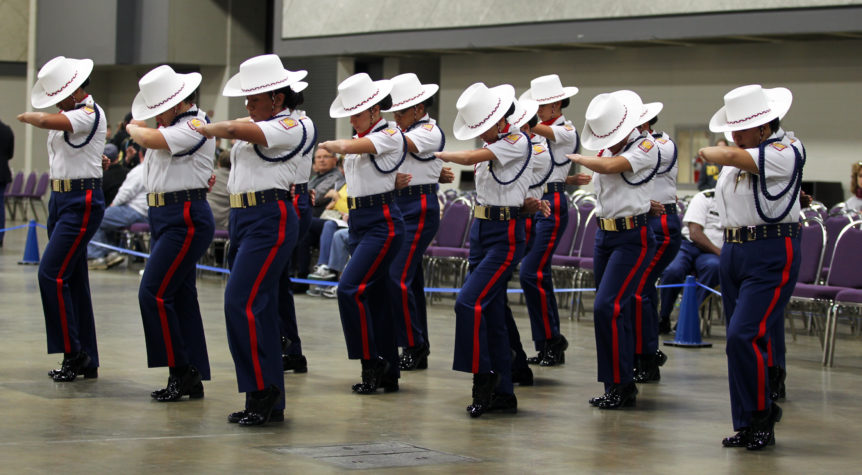 Articulation is to speak so that one is understood. It is not only about speaking clearly (enunciating words), but also about speaking clearly (using words that are easily understood for your audience). Got that? (photo courtesy of stripes.com)
Articulation is to speak so that one is understood. It is not only about speaking clearly (enunciating words), but also about speaking clearly (using words that are easily understood for your audience). Got that? (photo courtesy of stripes.com)
But what does this have to do with drill? Plenty.
A Driller can step onto the performance floor and not be clear; not articulate well. How is this accomplished if the Driller is not speaking? Through movement. A Driller communicates through movement. The Driller’s language is movement and an audience can ‘read’ that language.
Take a look at the primary image for this article, the unarmed female drill team. The image shows some clarity- see the variation of the position each cadet holds? This kind of variation is not what you want.
Considering the Language of Movement
A written/spoken language is made up of words which create sentences which, hopefully, communicate coherent/articulated ideas or thought. The same goes for a non-verbal language like drill: individual movements (words), body and equipment, create phrases (sentences) which communicate which again, hopefully, communicate coherent/articulated ideas or thought.
Movement
Consider each move a Driller makes as a word: facing movements, the positions of the manual of arms and then more advanced “words” would be exhibition-type movement. Movements make up a Driller’s vocabulary.
Youwouldneverwritelikethis,becauseit’sverydifficulttounderstand and not writin al of th letter of all o th wor wil driv yo mad! Not using punctuation (run-on sentences) creates frustration- you never know where the sentence ends and where to take a visual breath or break. Without punctuation, the ‘voice’ of what you are reading is lost: where are the highs and lows? Are these several words a phrase or are there two phrases? Plus there are other problems.
Just like the sentence above where the words are not completed, the most common way to not articulate well is to not complete movements. This is extremely common among Drillers. The Driller is thinking of the next move before the last one is finished and tends to not complete the last move. This has a great deal to do with the performance maturity of the Driller.
The sentence above without spaces between words mirrors the routine that is one long super-move or a routine of several super-moves (this is not a good thing). The audience needs to be able to see a separation between moves- not all moves, you need to find that balance.
Having a Wide Vocabulary
I talk about vocabulary here. And here.
Once you begin to increase your vocabulary, you will find it easier to create new moves. Vocabulary isn’t just about the rifle, sword or arm movements that you know. It’s also very much about marching/step style, head and body movement.
Variation!
While you need to vary your sentence and paragraph length and not repeat the same words over again, the same goes for a visual performance like military drill. Repetition is an effect killer and so is making your phrasing the same length or same style- like always ending a phrase with a big move (exclamation point).
Variation also applies to the same move executed a little differently.
Clarity and Logic
So, articulation is about clear communication. It’s also about making logical sense: placing moves where they follow others in a logical order and, if you are a soloist are part of a tandem, allowing the rifle to take you around the drill pad and not pushing the rifle around.
What do I mean by allowing the rifle to lead? A good example of “pushing the rifle around” is during your solo routine, executing a facing movement and then drilling of in that direction, facing another direction and doing the same thing. This kind of routine communicates a lack of understanding of routine design.


Comments 2
my question is for the Missing man table remonies I have seen the chair sitting upright and also leaning against the table which is pereferred or correct?
Author
Mr. Cannon,
Great question. Chairs with all four feet on the floor for the Missing Man (single setting) or Joint Service table setup. Chairs can be awkward for the Five Hat Ceremony, where honor guard members place service covers and other table items. A leaning chair is unnecessary and can cause a tripping hazard.
The answer to your question can also be found here: https://thedrillmaster.org/2012/04/26/the-powmia-ceremony/.
I hope that helps.